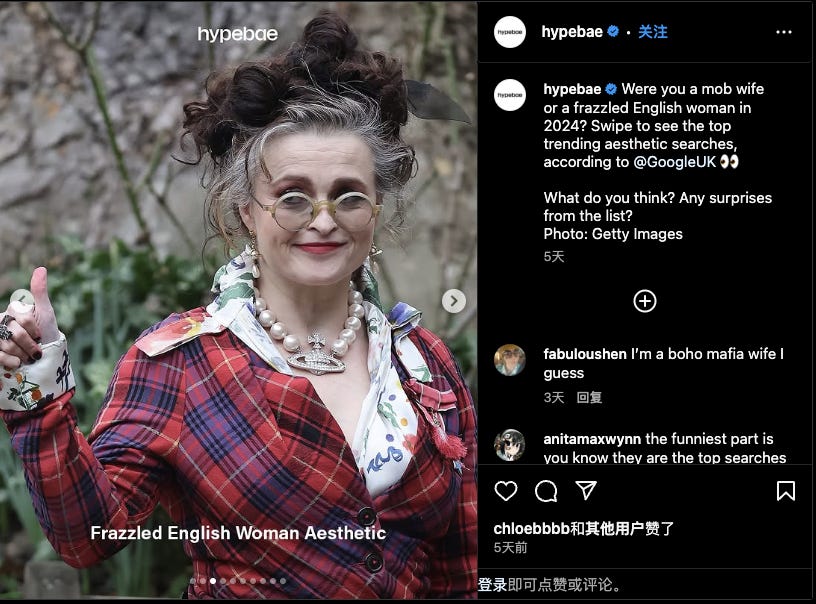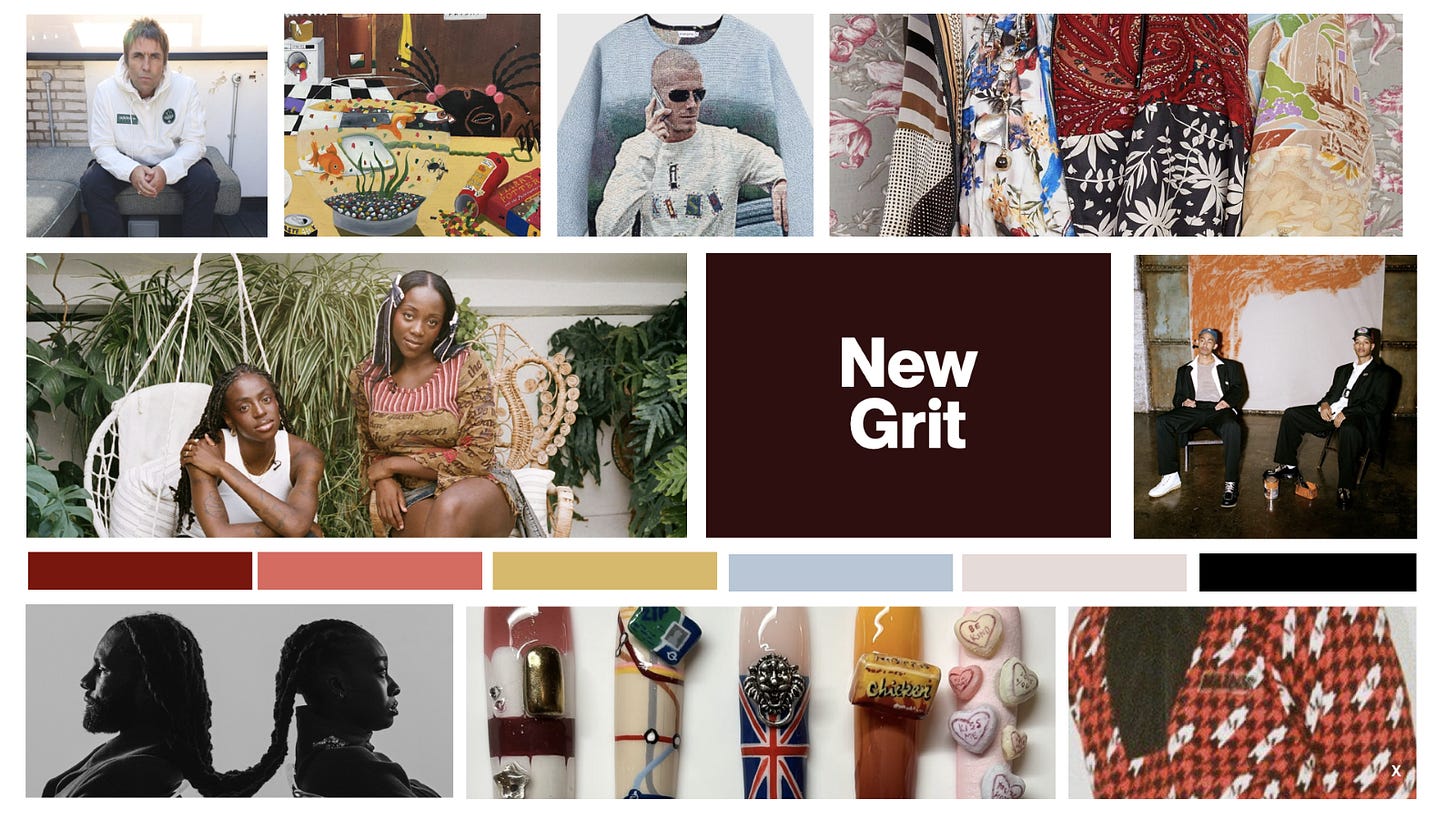Culture Drop, Issue 1 – U.K. Hun?
A cultural report distilling big topics into bite-sized insights. This issue? All Brit, no ish.
Run by “chronically online” creative strategists, Ruhi and Yra, Culture Drop unravels complex cultural landscapes across three key themes, Communities, Design and Brand. By distilling big topics into bite-sized insights we hope to bring shape to the intangibility of culture, delivering tangible insights that inform, delight and inspire.
Culture isn’t always just what’s popular right now. It evolves and accumulates over time, shaped by decades of reinforced messages, traditions, and shared narratives. These messages are embedded in everything from media and education to rituals and social norms. One important way culture shows up is through Nation Branding.
Nation Branding
A nation’s brand is like any other brand. Its perception and reputation built over time, through that country’s behaviours and messaging - both internally and globally. A strong nation brand can improve an economy, internal cohesion, and even support the brands that are built in that country resonate as they expand globally. Ultimately, culture and nation branding intersect, as the stories a nation tells and embodies become part of the broader cultural landscape, influencing how its people and its brands connect, engage, and identify with the world around them.
Cue Be Distinctive Britain!
In partnership with Ipsos and the British Chambers of Commerce, JKR has published an in-depth report into the current business landscape of Britain, and the impact Brand Britain has on homegrown brands. One thing is clear: Britain’s brand may be in doubt, but its power still holds.

While all three have an impact, Britain’s cultural identity garners the strongest positive perception among its citizens, ahead of Business and Politics. With the creative industries contributing £126 billion in gross value to the economy and the country ranking 4th globally in culture (as found in Be Distinctive Britain), it’s clear that culture is in fact Britain’s superpower.
We can take advantage of Britain’s superpower by gaining a better understanding of the state of current culture. In this issue, we’ll explore how communities, brands, and their design codes build modern Britain’s culture, how it came to be, and how it can help brands influence what’s ahead.
Right! So now let’s dive into it.
Chapter 1: Community
To Define a Nation
In "Be Distinctive Britain," we asked: "If Britain were a brand, what kind of shape would it be in?"
The idea of a “shape” implies a fixed structure, but British identity resists neat categorization.
Britain is in itself a kaleidoscope of lived experiences, where tension between global and local, and the past and future, makes defining its shape elusive. On top of that, it seems that the world has an outdated perception of what Britain is entirely (cue the 21 Savage memes).
Globalism and algorithm-informed realities have made fragmented identities a global phenomenon. It isn’t surprising that the nations Britain once mapped, controlled, and reshaped have now mapped and reshaped Britain in return. As a result, it seems that the very act of defining Britishness is an exercise in cultural negotiation.
Despite efforts to redefine Britishness, the narratives written by those with power continue to prevail. Be Distinctive Britain highlights that conservative boomers and men feel most hopeful about the nation's future. Meanwhile, only 20% of young Britons feel proud to be British. So what does this mean for the rest of the population that does not fit into the groups who feel most optimistic about Britain’s future?
Being British and the Issue with Monoliths
The tension surrounding British identity stems from clinging to a mythical, uniform culture—one that assumes everyone shares identical values, norms, and beliefs. While powerful, they crumble under the weight of lived experiences. Black and Asian communities have carved their own interpretations of a British identity for decades. That means, sometimes Britishness is defined in proximity to historical ideals; while for others, it’s about breaking away from those ideals entirely. The very existence of British icons like Ncuti Gatwa, Riz Ahmed, and Charli XCX disrupts the mythical monolithic narrative.
These identities are becoming further fragmented by the day through algorithms, where Britishness is different depending on which streets of London you live in. For example, across cities in the UK and boroughs in London, hyperlocal meme pages have emerged that celebrate the hyper-niche codes and behaviours that represent the community.
The reality is, people are no longer seeking belonging through comprehensive, all-encompassing identities, but through specific, curated spaces that reflect aspects of their multifaceted selves. The multi-hyphenate British identity is therefore not a dilution, but an expansive, generative mode of cultural being and community connection. Then, the question is no longer "If Britain were a brand, what kind of shape would it be in?” but "How do we define a shape where different parts of a British experience can authentically co-exist?"
So what does this mean for brands?
British brands have long told monolithic British stories, but the most compelling stories now focus on transformation. Britishness derives its power from its capacity to hold multiple, seemingly contradictory identities simultaneously. Brands must learn to exist in this state of nuanced complexity, moving beyond homogeneous storytelling towards a more fractal approach to identity. Take for example the Union Jack, a quintessential British symbol that has undergone radical reinterpretation. Once a heritage-ladden code, then becoming a symbol of the far-right movement, to now being reclaimed by artists and communities who challenge its historical and contemporary meaning (see A.G. Cook’s album cover for “Britpop”).

Consider Nike's iconic "Nothing Beats a Londoner" campaign. By challenging the traditional Western-London definition and highlighting marginalized experiences, they've offered insight into an evolving identity. Burberry’s first campaign under new Creative Director Daniel Lee featured Shygirl and Skepta, signifying a push towards a multifaceted, heritage-driven British identity.

So what?
Instead of representing a monolithic idea of “Britishness”, brands must instead highlight specific, authentic fragments of the British experience. The most powerful brands will be those that don't just reflect this new reality, but actively create space for it. Their role is not to define Britishness, but to provide a canvas on which multiple, dynamic expressions of identity can emerge and co-exist.
Chapter 2: Design
Brit-coded
We’ve spoken about Britain’s fragmentation and fluidity, but how does this identity translate to visual codes and aesthetics? While reducing an entire nation to a moodboard is a challenge better resigned to the likes of Pinterest, we at Culture Drop HQ are trying our hand at it, nonetheless.
Strap in, as we summarize Britain’s most notable design codes across three key areas; Anglo Traditional, Punk Modern and New Grit.
Long synonymous with British style, “Anglo Traditional” is marked by a sense of utility and craft, mirroring the understated personality often associated with Britishness. The original quiet luxury, design aesthetics feel resolute and stoic, expressing quality through elevated structure and detail. The countryside remains a key area inspiration for this aesthetic. Best exemplified by Burberry, Barbour, and designer Althea Niche, design leverages earthy tones, rich landscapes and simple details to reflect the heritage and practices that made Britain what it was.
The 1970’s marked the move to “Punk Modern”. Here, design is anchored in a sense of rebellion, rallying against the status quo through overtly subversive design cues. This is brought to life through layered type, expressive colours and bold, punchy graphics, with creators like Vivienne Westwood and Jamie Reid key in bringing the aesthetics to life.
As punk rebellion became readily absorbed into the mainstream, subversion needed a new angle. One that focused less on resisting conformity and more on championing innovation and cultural pride. A fusion of old and new, this design aesthetic is ironic and self-referential, offering a contemporary take on tradition through rich and storied cultural references. Design codes are playful, nostalgic and raw with creatives like Shaquielle Aaron-Keith and Marine Serre best representing this trend.
So What?
This range of design codes emphasizes the diversity of the nation’s creatives, all of whom draw inspiration from a rich and diverse cultural heritage. Rather than total reinvention, impact lies in taking reference from the past, drawing from the multiplicity of Britishness and using it to bolster the future.
Chapter 3: Brand
A bit of banter ™
True to their imperialist routes, British cultural capital has always been high on the export list – and with good reasons. British heartthrobs, British lingo, and British rap are just a few cultural caches that keep the U.K. at the top of our “most influential list”. And while we may have Central Cee to thank for at least two of these, British humour, and its inherent relatability seem to be the connecting factor. British brands are taking note, leveraging humour to engage with a new generation of consumers.
Take British Icon, Heinz, who’ve warped the confines of space and time to create a sauce that includes 14 Heinz condiments, in one glorious bottle. The aptly named “Every Sauce” was readily celebrated by the British public who, like most of us, buckle under the pressure of having to choose between ketchup or mayo. While not necessarily a British brand, Heinz continues to purvey Britishness through both product and comms, even tapping Adele to promote a sense of quintessential British wit.

Premium sectors are also capatalising on British banter. In new work by Uncommon, British Airways offers a playful take on the typical “out of office” message. Their out-of -home ads parody the best of British stereotypes (like a lack of high-quality produce) and the joys that come from leaving them all behind.

And what’s a British brand round up without Burberry? The Brand’s newest campaign "It’s always Burberry Weather” celebrates the misfortune, unpredictability, charm that is British weather. Tapping the likes of Zhang Jinyi and Olvia Coleman, we see our heroes overcome the trial and tribulations of rain, sleet and sheep all with the grace and poise of the Queen herself. What’s not to love?
So What?
At a time when everything feels (and frankly is) rather heavy, audiences are looking to brands for a moment of lightness. With 80% of people more likely to buy from brands that use humour, and 1/3 of Brits preferring to buy British, humour acts as a powerful amplifier, providing levity without ignoring the status quo. Whether it be through innovation or advertising, consider where your brand can disrupt with delight.
That’s it for our very British Edition of Culture Drop. Tune in next month for more musings and mischief.
Questions, compliments or complaints? Shoot us an email on the below
Yra Lougheide-Camejo – Senior Strategist
Yralougheide-camejo@jkrglobal.com
Ruhi Kokal – Strategist
Sources for Moodboards, left to right:
Anglo Traditional
First Row: Barbour 1990, Rose Sinclair for Crafts Council, END. X Adidas SPZL, Burberry
Second Row: Heinz, Barbour, Burberry
Punk Modern
First Row: Sex Pistols, Vogue, Dr. Martens x Eleven Miles
Second Row: Vivienne Westwood, Interview Magazine
Third Row: Vivienne Westwood, Wonderland Magazine Stormzy x Banksy, Dazed Digital, Creative Boom
New Grit
First Row: Culted, Instagram User @shakka.d.badmon, KNITWRTH, Charli XCX
Second Row: Rachel Chinouriri for DORK, Rizzle Kicks
Third Row: X User @Wretch32, Instagram User @setgyallery, MAINS by Skepta










Such a good one!!! Love this subject, I’ve done a report of fashion branding fashion too, you can check it here https://open.substack.com/pub/gaelpineirobeiraselmedia/p/moodreport-nation-branding-in-fashion?r=2m0mci&utm_medium=ios
Quality!